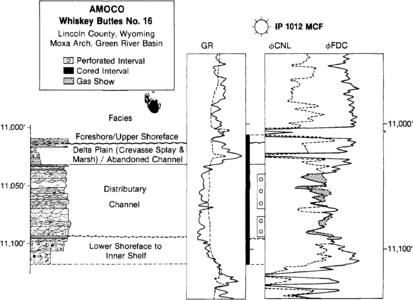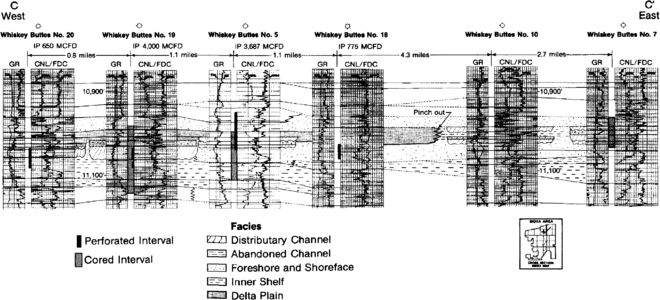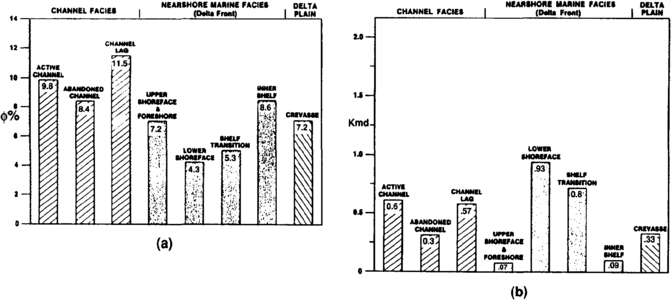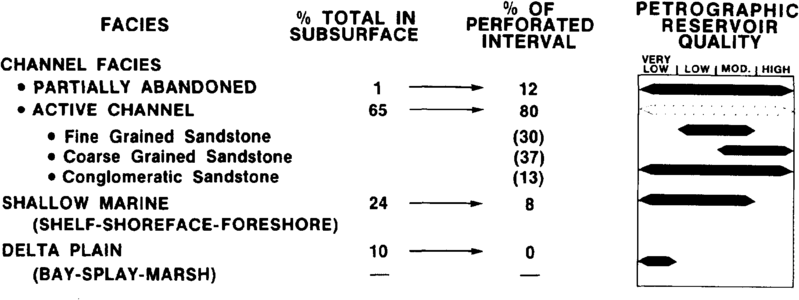Difference between revisions of "Tight gas reservoirs: evaluation"
Cwhitehurst (talk | contribs) |
Cwhitehurst (talk | contribs) |
||
| Line 37: | Line 37: | ||
===Stratigraphic cross sections=== | ===Stratigraphic cross sections=== | ||
| − | Lateral variability in facies relationships, and thus reservoir continuity and heterogeneity, are best determined from the construction of stratigraphic [[cross section]]s. An example of a cross section through part of a tight gas reservoir is shown in [[:file:evaluating-tight-gas-reservoirs_fig2.png|Figure 2]]. Facies interpretations are based on [[core description]]s and extrapolation of log signatures for each cored facies to adjacent uncored wells. [[Distributary channel]] sandstones form the reservoirs, and bay, marsh, and crevasse splay mudstones form the seal. The lack of production in the two wells to the east is attributed to the pinching out of these mudstone facies and substantiates its importance as a stratigraphic seal. Note the laterally discontinuous nature of individual reservoir sandstone beds as depicted in the cross section. | + | [[Lateral]] variability in facies relationships, and thus reservoir continuity and heterogeneity, are best determined from the construction of stratigraphic [[cross section]]s. An example of a cross section through part of a tight gas reservoir is shown in [[:file:evaluating-tight-gas-reservoirs_fig2.png|Figure 2]]. Facies interpretations are based on [[core description]]s and extrapolation of log signatures for each cored facies to adjacent uncored wells. [[Distributary channel]] sandstones form the reservoirs, and bay, marsh, and crevasse splay mudstones form the seal. The lack of production in the two wells to the east is attributed to the pinching out of these mudstone facies and substantiates its importance as a stratigraphic seal. Note the laterally discontinuous nature of individual reservoir sandstone beds as depicted in the cross section. |
===Petrophysical properties of reservoir facies=== | ===Petrophysical properties of reservoir facies=== | ||
Revision as of 17:25, 21 March 2016
| Development Geology Reference Manual | |

| |
| Series | Methods in Exploration |
|---|---|
| Part | Geological methods |
| Chapter | Evaluating tight gas reservoirs |
| Author | Thomas F. Moslow |
| Link | Web page |
| Store | AAPG Store |
Gas reservoirs with estimated in situ gas permeabilities of 0.1 md (millidarcy) or less are officially recognized by the U.S. Federal Energy Regulatory Commission (FERC) as “tight gas reservoirs.” This absolute value for classification as a tight gas reservoir was critically important during the late 1970s and early 1980s to qualify for federally allowed enhanced prices of tight gas. Since that time, however, and for all practical purposes, a tight gas reservoir is generally recognized as any low permeability formation in which special well completion techniques are required to stimulate production (Table 1). The most commonly used recovery technique is hydraulic fracturing, without which many tight gas reservoirs would not be economical (see Stimulation). Thus, most low permeability gas reservoirs are considered “unconventional.”
Low permeability gas-bearing formations occur in almost all gas-producing sedimentary basins worldwide. In North America, the vast majority of tight gas reservoirs can be grouped into two main geological categories: (1) Devonian shales from eastern United States and Canada, and (2) low permeability sandstones from throughout the United States and from the Western Canada Sedimentary basin.[1] It has been estimated that in the United States alone, tight sandstone formations are likely to have recoverable reserves ranging from 100 to 400 tcf, and Devonian shales have recoverable reserves of up to 100 tcf;[2] cited in Spencer and Mast.[1] The successful exploitation of tight gas resources in the future will depend in large part on advancements made in the proper geological evaluation of low permeability reservoirs.
Tools and methods
Figure 1 A cored sequence of tight gas reservoir facies and correlations to electric log responses of the Frontier Formation, Green River basin, Wyoming. Lithologies and sedimentary characteristics are summarized in this kind of description; facies and environments of deposition are shown on the right. (From Moslow and Tillman.[3])
Figure 2 The depositional dip-oriented cross section through the Frontier Formation, Moxa arch area, Wyoming, showing facies relationships and inferred geometries. (Modified from Moslow and Tillman.[3])
Figure 3 Histograms showing (a) average porosity values and (b) average permeability values for cored tight gas reservoir facies. (From Moslow and Tillman.[3])
Figure 4 Correlation of sedimentary facies and lithologies to petrographic reservoir quality. Distribution of reservoir facies in the subsurface Is compiled from observations of cores, well logs, and cross sections. (From Moslow and Tillman.[3])
The extremely low permeability of tight gas reservoirs severely restricts the ability of gas to migrate appreciable distances. Consequently, the most important geological characteristic of this type of reservoir is the nature and distribution of porosity and permeability (Table 1). The most common reason for the minimal permeabilities is the occlusion of interstitial pore throats by detrital or authigenic clays or cement (see Rock-water reaction: formation damage). Thus, a proper geological evaluation of tight gas reservoirs requires a multidisciplinary approach to assess the depositional and diagenetic controls on reservoir quality and heterogeneity.
Facies determinations
Since most tight gas reservoirs in North America are of detrital origin (shale, siltstone, and sandstone), primary processes of deposition, inferred from the examination of sedimentary characteristics in core, can have a strong impact on preserved porosity and permeability trends. An example of a sedimentological description and environmental interpretation of cored facies from a tight gas reservoir is shown in Figure 1.
Core to log correlations
Documenting characteristic log signatures for reservoir facies can provide a valuable tool for constructing regional cross sections, determining facies relationships, and extrapolating reservoir geometries in areas of minimal or nonexistent core control (see Quick-look lithology from logs). Commonly, the gamma ray log provides the most distinctive log signature for individual facies (Figure 1). For low permeability gas reservoirs, crossover of the compensated neutron-formation density logs is the most reliable well log for indicating gas-saturated and porous intervals and for determining which intervals in the reservoir should be perforated and/or stimulated by hydraulic fracturing.
Stratigraphic cross sections
Lateral variability in facies relationships, and thus reservoir continuity and heterogeneity, are best determined from the construction of stratigraphic cross sections. An example of a cross section through part of a tight gas reservoir is shown in Figure 2. Facies interpretations are based on core descriptions and extrapolation of log signatures for each cored facies to adjacent uncored wells. Distributary channel sandstones form the reservoirs, and bay, marsh, and crevasse splay mudstones form the seal. The lack of production in the two wells to the east is attributed to the pinching out of these mudstone facies and substantiates its importance as a stratigraphic seal. Note the laterally discontinuous nature of individual reservoir sandstone beds as depicted in the cross section.
Petrophysical properties of reservoir facies
Average core analysis values for porosity, permeability, oil, gas, and water saturation should be determined for each facies recognized to identify those facies of greater and lesser reservoir quality (Figure 3a). In gas-bearing sandstones, very low values of porosity and permeability are acceptable and expected. While the average air permeability values rarely exceed 1.0 md (millidarcy) for tight gas reservoirs, a significant difference in permeability values often occurs between facies (Figure 3b).
Anomalously high values from core analysis measurements may also identify zones of fracture porosity and permeability in tight gas reservoirs (see Evaluating fractured reservoirs). However, one must be careful in interpreting such results because erroneously high measurements can also be produced by bypassing or artificial fracturing of core samples during analysis. Checks should be made to ensure that a sufficient number of samples have been analyzed for each facies or unit and that permeability and porosity values correspond to observed lithologies in core.
Petrological and mineralogical assessment
A petrological thin section, SEM, and X-ray diffraction analysis of core samples from each sedimentary facies is highly recommended in any geological evaluation of tight gas reservoirs (see Thin section analysis and SEM, XRD, CL, and XF methods). Analyses of several tight gas sandstones have attributed the low average permeabilities, and thus poor reservoir quality, to the presence of authigenic or detrital clays or cements.[4][1] Since the occurrence of these constituents can be quite variable within a depositional system and can be facies dependent, a broad range of porosities, permeabilities, and gas saturation values often exists in any reservoir (Figure 4). Identifying and mapping those units of greatest reservoir potential are key to a successful evaluation.
The common association of clays with tight gas reservoirs makes them very sensitive to formation damage. Hydraulic fracturing is therefore the least destructive and most preferred well stimulation technique.
See also
- Introduction to geological methods
- Lithofacies and environmental analysis of clastic depositional systems
- Subsurface maps
- Flow units for reservoir characterization
- Effective pay determination
- Cross section
- Evaluating structurally complex reservoirs
- Conversion of well log data to subsurface stratigraphic and structural information
- Reservoir quality
- Carbonate reservoir models: facies, diagenesis, and flow characterization
- Fluid contacts
- Geological heterogeneities
- Evaluating fractured reservoirs
- Evaluating stratigraphically complex fields
- Evaluating diagenetically complex reservoirs
References
- ↑ 1.0 1.1 1.2 Spencer, C. W., Mast, R. F., 1986, Introduction, in Spencer, C. W., Mast, R. W., eds., Low Permeability Sandstone Reservoirs: AAPG Studies in Geology Series, n. 24, p. iv–vi.
- ↑ Office of Technology Assessment, 1985, U., S. natural gas availability—gas supply through the year 2000: U. S. Congress Office of Technology Assessment, OTA-E-245, 252 p.
- ↑ 3.0 3.1 3.2 3.3 Moslow, T. F., Tillman, R. W., 1986, Sedimentary facies and reservoir characteristics of Frontier Formation sandstones, southwestern Wyoming, in Spencer, C. W., Mast, R. F., eds., Low Permeability Sandstone Reservoirs: Studies in Geology Series 24, p. 271–295.
- ↑ Masters, J. A., 1984, Elm worth—Case Study of a Deep Basin Gas Field: AAPG Memoir 38, 316 p.



